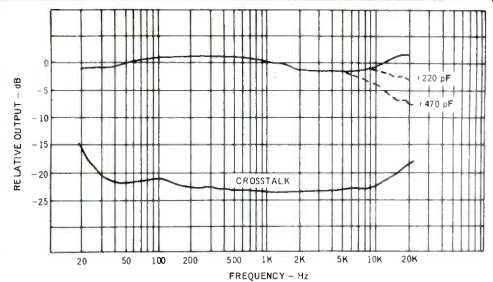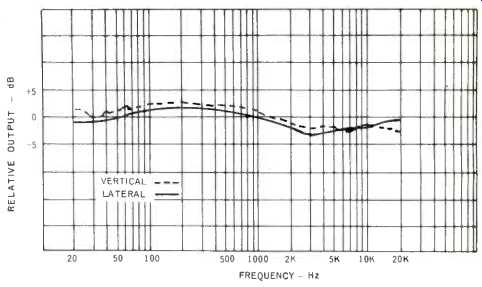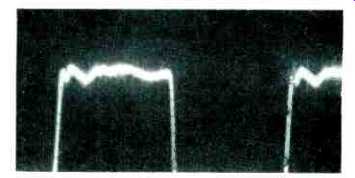
MANUFACTURER'S SPECIFICATIONS:
Frequency range: 20 to 20,000 Hz.
Separation: greater than 25 dB.
Output: 0.7 mV/cm/sec.
Recommended Stylus Force: 3/4 to 1 1/2 grams.
Stylus: Elliptical, 0.2 x 0.7 mil radii, user replaceable.
Weight: 5 grams.
Price: $49.95.
This is one of a new series of high-trackability stereo cartridges made in the same general pattern as the V-15 Type II Improved, which is the leader in the Shure line. The latter is intended for use on highest-quality turntables, whereas the M91 is perhaps slightly sturdier, and for use on good turntables, both manual and automatic. In any case, the performance is nearly equal to the more expensive model.
We made all the usual measurements on the cartridge before ever listening to it, as is our custom, and found that the output was somewhat higher than specifications, being of the order of 1.75 mV/cm/sec--that is, an output of 6.2 mV for the 1000-Hz modulation of 3.54 cm/sec on a test record.
Frequency response, as shown on the curve, is within It 2 dB from 20 to 20,000 Hz, showing a slight rise at 19,000 Hz with our normal cable capacitance of 250 pF. However, Shure recommends a higher cable capacitance, so further curves were run with additional capacitances of 220 and 470 pF, with the results shown on the curve. Separation measured 23 dB at 1000 Hz, slipping only to 18 dB at 20,000 Hz, which is exceptionally good. At 10,000 Hz the separation continued at 23 dB. From these observations, it would appear that a total cable capacitance of 350 to 400 pF would give the flattest response, since the additional 220 pF across the cable capacitance of 250 pF showed a slight droop at 20,000 Hz, and considerably more with the addition of 470 pF. It is noted, however, that the M91E is not as susceptible to the high-frequency peaking with less-than-recommended cable capacitance as is the V-15 II Improved, which does show a noticeable peak at 19 kHz unless the capacitance approaches the recommended value of 450 pF.

Fig. 1--Frequency responses and separation curves as made from the B & K
QR-2009 sweep-frequency test record. Note the differences in top-end response
with change in cable capacitances. Apparent optimum flatness should be obtained
with a total cable capacitance of about 300 to 350 pF.

Fig. 2--Comparison of response of Shure M91 E cartridge to lateral and vertical
sweep bands of the test record. Note consistency of the responses to the
two modes-a condition rarely encountered in stereo cartridges.
The d.c. resistance of the M91E measured 590 ohms per coil, with an inductance of 890 mH, which is about normal for modern stereo cartridges. Measurements of IM distortion, using the CBS STR 111 record, gave figures of 1.8 per cent for the lateral signal consisting of 200 and 4000 Hz at +9 dB, and of 3.9 per cent for vertical modulation of the same frequencies at a level of +6 dB-the two frequencies and levels on which we report, after making the complete series of sixteen measurements. All of these values are within the normal range for modern stereo cartridges.
Using the CBS BTR-150 Broadcast Test Record, the tracking capability was observed. The frequency of this test cut is 300 Hz, with amplitudes referred to 1.12 x 10^-3 cm, and cuts of +6, +9, + 12, and + 15 and + 18 dB with respect to the reference in the lateral mode, with amplitudes of +6, +9, and + 12 with respect to the same reference in the vertical mode. The M91E tracked all cuts perfectly with the exception of the + 18 band, lateral, in which some mistracking was observed. Remember that this test is made at 300 Hz, which is in a range of constant amplitude recording, so it is a very rigorous test.

Fig. 3--'Scope pattern of response of Shure M91 E stereo cartridge to 1000-Hz
square wave band of CBS STR-111 test record.
The final proof of the performance of a stereo cartridge is determined by listening to records that are familiar to the observer, and by playing the Shure demonstration record--the Obstacle Test for stereo cartridges. Naturally, the M9IE performed flawlessly on this record, as would be expected, since the company must make their cartridges show us well on their own demonstration record. But when we played a number of our old favorites, we could still find no fault with the M91E. It is clean, free from any peaks, and particularly from the "wiriness" often found with stereo cartridges. The absence of any peaks in the response curves should tell this story, just as well as the listening does, but most of us do not use cartridges to satisfy measuring equipment-only our ears. And in this category, the Shure M91E does a most creditable job.
One thing that we noticed in the measurement procedure was that the response curves made from the lateral and vertical sweeps of our standard sweep cord--B & K QR-2009--were remarkably similar, a condition that we have never observed before in a stereo cartridge. In most cases, the vertical response drops off appreciably above 10,000 Hz, and is likely to show considerable variance from "flat" response in the range below 100 Hz. However, in the case of the M91E, the two responses varied no more than 1 dB from each other throughout the entire range from 30 to 15,000 Hz, with an increase to about 2 dB difference at 25 Hz and at 20,000 Hz. We do not have a wide experience with this particular test, but we shall certainly include it in future cartridge examinations. This observer has long believed that the reason two amplifiers--or systems, or whatever-measured alike but sounded different was that there was some parameter we were just not measuring. In amplifiers, we would expect it to be phase difference, but so far no one seems to have come up with any reliable data showing the comparisons of phase response. Perhaps the measurement of lateral and vertical responses may help to show why cartridges sound different even though they may appear to measure alike.
-C. G. McProud
(Audio magazine; Apr. 1973)
Also see:
Shure V15 Type IV Phono Cartridge (Equip. Profile, Feb. 1979)
Shure V15 Type V Phono Cartridge (Nov. 1982)
Satin M-18BX Moving-Coil Phono Cartridge (Dec. 1978)
Signet TK10ML moving-magnet phono cartridge (Feb. 1985)
= = = =